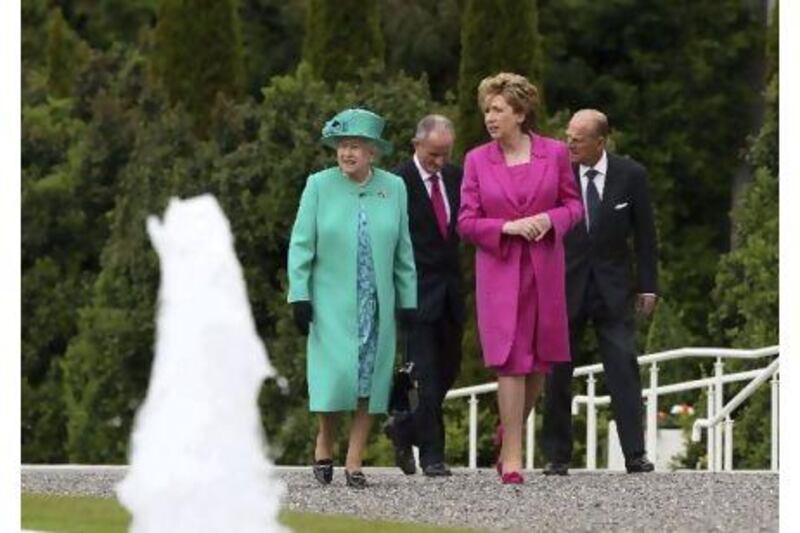DUBLIN // A sombre Queen Elizabeth II laid a wreath yesterday at a memorial for the victims of Ireland's independence struggle in a landmark gesture on the first visit by a British monarch to the Irish republic.
Queen Elizabeth, 85, began her historic four-day trip surrounded by Ireland's biggest ever security operation as the discovery of a bomb near Dublin underscored the lingering threat from dissident republicans.
Wearing white, the queen appeared unperturbed as she stood shoulder-to-shoulder with the Irish president, Mary McAleese, during the wreath-laying ceremony at the Garden of Remembrance in Dublin.
But the hushed atmosphere contrasted with the noisy scenes outside where several hundred republican protesters demonstrated against the queen's visit and burnt a British flag.
The queen arrived 100 years after her grandfather George V visited Dublin and an Ireland that was still part of the British Empire.
Beaming smiles by the queen and Mrs McAleese, a Belfast-born Catholic who has spent 14 years lobbying for Elizabeth II to visit, demonstrated genuine warmth between the two women, who have met several times before.
Mrs McAleese said Britain and Ireland were "determined to make the future a much, much better place". The queen did not comment ahead of her planned speech tonight at Dublin Castle, the former seat of British rule of Ireland.
Four fixed-wing propeller aircraft from Ireland's minuscule Air Corps flew overhead in tight formation as a white-gloved, gun-toting honour guard stood to attention.
Inside the president's residence, Mrs McAleese introduced the queen and her husband, Prince Philip, to the Irish prime minister, Enda Kenny. Outside, the queen introduced the president to the British foreign minister, William Hague. The two leaders then planted a tree as two children rang the residence's Peace Bell.
A 33-motorcycle police escort led the queen to Mrs McAleese's residence in Dublin's vast Phoenix Park through the unusually empty streets of Dublin - cleared to ensure no anti-British extremist could launch an attack. Nearby Dublin Zoo was closed as a security precaution and no civilian aircraft were permitted over Dublin for the day.
Irish Republican Army dissidents opposed to reconciliation with Britain still tried to undermine the visit with real and hoax bombs, but they caused no significant disruption.
Irish Army experts overnight defused one pipe bomb on a Dublin-bound bus that was detected in Maynooth, 25 kilometres west of the capital. Police said the bomb was properly constructed but not primed to detonate.
A second device abandoned near a light-rail station in west Dublin was deemed a hoax yesterday morning. Later, police responded to at least two more reports of suspicious packages in working-class districts of north Dublin, but no further bombs were confirmed.
Police said IRA dissidents using a recognised codeword warned about the bus bomb, which was left in overhead luggage.
Several small IRA splinter groups concentrated along the Irish border continue to plot gun and bomb attacks in Northern Ireland in hopes of undermining the success of its 1998 peace accord, particularly its stable Catholic-Protestant government.
But Irish and British officials were keen to stress that the queen's visit to Dublin, Kildare, Tipperary and Cork would proceed as planned, accompanied by the biggest security operation in the Republic of Ireland's history.
Mr Kenny said: "This is the start of an entirely new beginning for Ireland and Britain. I really do hope that the welcome she gets will be genuine and memorable for her."
On her first day in Dublin, the queen was also visiting Trinity College, founded in 1592 by her royal namesake, Queen Elizabeth I.
More than 8,000 police, two thirds of the entire country's police force, shut down key roads in central Dublin and erected pedestrian barricades for several kilometres. About 1,000 Irish troops were kept in reserve.
Police made it extremely difficult for protesters to get within sight of any of the queen's engagements. Onlookers were given few vantage points to see the queen unless they had been included in carefully vetted guest lists.






